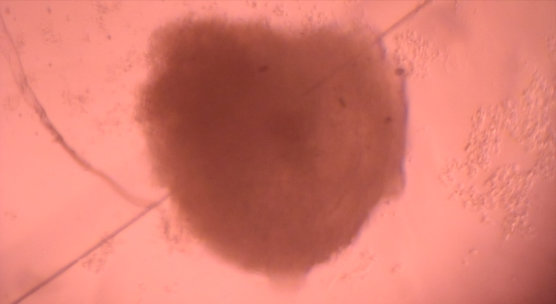Art from mini human hearts – new exhibition opens
Published On Mon 14 Sep 2015 by Grant Hill

Miniature beating human hearts and a periodic table of emotions are the inspiration behind an exciting new joint exhibition opening at Abertay University and the University of Dundee.
Made from stem cells, the mini hearts have been developed by the medical biotechnologist Professor Nikolai Zhelev to find a cure for heart disease, and the exhibition – entitled ‘Hearts & Minds’ – explores the function, power and frailty of the heart and brain from many different biological and emotional perspectives.
Through 3D projections, games design, the moving image and conceptual art to name but a few of the installations, ‘Hearts & Minds’ showcases the work of internationally renowned artists, as they explore some of the world’s most incredible scientific breakthroughs.
In ‘Hearts’ – which opens at Abertay’s Hannah Maclure Centre on Monday, 14th September – the work of Fife-based conceptual artist Martin John Callanan draws directly upon the research of Professor Zhelev to consider the idea of a Hybrid Heart: a single mini heart produced from the combined DNA of two distinct humans.
Canadian artist Ingrid Bachmann, meanwhile, considers the experience of heart transplant recipients, powerfully portraying their gestures, stories and emotions through sound installations, accompanied by sculptures that expand and contract, evoking the human heartbeat.
In ‘Minds’ – which opens at LifeSpace on Friday 18 September – a new work by Aidan Moesby called ‘Sagacity’ uses tweets (with the hashtag #dundeefeels) to determine how the people of Dundee are feeling day to day, and suggests the feedback loop that exists between our brain, our mood, and our bodily behaviour.
Also at LifeSpace, Tamsin van Essen’s work in ceramic transforms sentimental objects into physical reminders of the lesions that can plague the healthy tissue of the brain.
Clare Brennan – Curator of Abertay University’s art gallery the Hannah Maclure Centre – explains the idea behind ‘Hearts’:
“The heart is intrinsically linked with our emotions – we speak of heartbreak and heartache, love and romance at the drop of a hat, but we rarely think about the organ that faithfully beats inside our bodies keeping us alive.
“It is our first-formed organ and once formed very few of its cells can regenerate. So the heart is extremely fragile and needs to be looked after.
“Dundee is famed for its scientific breakthroughs, with the blood pressure lowering beta-blockers being invented by Sir James Black – former Chancellor of the University of Dundee – as well as the polygraphs that can detect anomalies in our heartbeats.
“More recently, Professor Nikolai Zhelev from Abertay has found a way to cure a form of heart disease, which is what sparked the idea for the exhibition.”
Curator of the ‘Minds’ aspect of the joint exhibition, Sarah Cook, adds:
“We are so glad to be working together across two venues to bring the research happening in Dundee to life, at both the Hannah Maclure Centre and at LifeSpace. Not everyone is going to read a scientific paper or news article, but they might be interested in coming to an exhibition so it’s a great way to help science reach new and different audiences.
"We think it's also important to bring creative minds into these conversations, not just to translate or make the research more accessible, but also to challenge thinking, ask questions that wouldn't normally be asked, to subvert the ideas and to tell the human, social and emotional sides to research."
In addition to the work of Callanan and Bachmann ‘Hearts’ features the work of Catherine Richards’ perspective-shifting 3D projection piece, which was inspired by a collection of heart-shaped gifts given to a renowned cardiologist by her heart transplant patients.
A previous work by Richards that she created in collaboration with the artist Martin Snelgrove also features. It is a web-based game called Charged Hearts (1996) that examined the relationships of physics, emotion and communications technologies of the time.
Unfortunately, through obsolescence of technology and software, the game has been lost to the internet.
However, through conversations between the co-curators, the idea was formed to revive and reimagine it, so the exhibition will host a live game jam, where teams and individuals are invited to take inspiration from the game and create new interactive artworks which further speculate about the mediation of emotion by technologies.
Finally, Jennifer Kelly, a Masters student from Duncan of Jordanstone College of Art and Design (DJCAD) explores the idea of the heart as a ‘thinking organ’ with her beautifully delicate, but anatomically accurate, ceramic hearts.
Kelly’s piece is accompanied by the reading of a Venetian prayercard about sacrificing the heart, which inspired the installation.
‘Minds’ also includes the work of a graduating Masters student from DJCAD, Ingrid Bell, who has turned MRI brain scans into prints that are responsive to touch.
A film about the aging brain by Anne Milne and prints and sculptures about how cells communicate by Jim Pattison also feature.
ENDS
For media enquiries please contact Chris Wilson T: 01382 308 522 M: 07837 250 284
Notes to Editors:
‘Hearts’ previews on Friday, 11th September from 6-8pm and runs until Friday, 23rd October in the Hannah Maclure Centre at Abertay University.
‘Minds’ previews on Friday, 18th September from 5-7pm and runs until Saturday 18th October in LifeSpace at the University of Dundee.
‘Sagacity’ was commissioned by Dundee Contemporary Arts in partnership with the Small Society Lab, the University of Dundee and Duncan of Jordanstone College of Art and Design. It was supported by New Media Scotland's Alt-W fund.